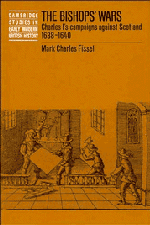Book contents
- Frontmatter
- Contents
- List of Maps
- Preface
- List of abbreviations
- 1 THE EVENTS OF THE BISHOPS' WARS AND CAROLINE POLITICS
- 2 INSTITUTIONS
- 3 MILITARY FINANCE
- 4 RELUCTANT LORDS AND ABSENT MERCENARIES
- 5 THE PERFECT MILITIA
- 6 IMPRESSMENT AND THE SUBSTITUTION CLAUSE
- 7 RIOT, ICONOCLASM, AND MURDER AMONGST THE SOLDIERY
- 8 CONCLUSION
- Bibliography
- Index
- Cambridge Studies in Early Modern British History
7 - RIOT, ICONOCLASM, AND MURDER AMONGST THE SOLDIERY
Published online by Cambridge University Press: 03 May 2011
- Frontmatter
- Contents
- List of Maps
- Preface
- List of abbreviations
- 1 THE EVENTS OF THE BISHOPS' WARS AND CAROLINE POLITICS
- 2 INSTITUTIONS
- 3 MILITARY FINANCE
- 4 RELUCTANT LORDS AND ABSENT MERCENARIES
- 5 THE PERFECT MILITIA
- 6 IMPRESSMENT AND THE SUBSTITUTION CLAUSE
- 7 RIOT, ICONOCLASM, AND MURDER AMONGST THE SOLDIERY
- 8 CONCLUSION
- Bibliography
- Index
- Cambridge Studies in Early Modern British History
Summary
The Bishops' Wars aimed at buttressing the monarch's religious and political authority. The disorders of the common soldiers made a mockery of royal authority, for mutinies and violence perpetrated by instruments of royal policy made clear the enormous gap between Charles's notions of absolutism and the political failure which made its enforcement impossible. How could a King expect the obedience and loyalty of his subjects while his own soldiers ran amok? Worse, these low-born troopers questioned the lofty theological and ideological arguments which the Crown made against the Covenant. The religious context of the war, in a campaign accompanied by acts of iconoclasm, brought the political question of the purpose of the war to the forefront. Although the campaign of the previous year had seen the disorder that customarily accompanied early modern armies (such as brawling, theft of livestock, etc.) the violence of 1640 was more pronounced and of a different character. Most riot in summer 1640 focussed upon property, secular and ecclesiastical, and was symptomatic of political collapse. Enclosure railings were dismantled in Derbyshire and Staffordshire. Communion railings were destroyed in Essex and Hertfordshire. The disturbances of 1640 reached their zenith in cruelty toward alleged Catholic officers.
Iconoclasm: godly religion or simple riot?
Dr Barkham, the parson of Bocking, presented Captain Rowlston's company with fifty shillings and a barrel of beer after muster on the morning of 22 July 1640, at Braintree, Essex.
- Type
- Chapter
- Information
- The Bishops' WarsCharles I's Campaigns against Scotland, 1638–1640, pp. 264 - 286Publisher: Cambridge University PressPrint publication year: 1994



